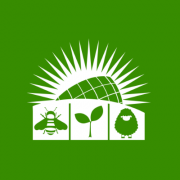Crop Production in Partial Shade of Solar Panels on Trackers
Kale, chard, broccoli, peppers, tomatoes, and spinach were grown at various positions within partial shade of a solar photovoltaic array during the growing seasons from late March through August 2017 and 2018. The rows of panels were orientated north-south and tracked east to west during the daylight hours, creating three levels of shade for the plants: 7% of full sun, 55-65% of full sun, and 85% of full sun, as well as a full sun control outside the array. Average daily air temperature at canopy height was within +\- 0.5oC across the shade conditions. Over two field seasons, biomass accumulated in correction with the quantity of photosynthetically active radiation (PAR). Kale produced the same amount of harvestable biomass in all PAR levels between 55% and 85% of full sun. Chard yield was similar in PAR levels 85% and greater. Tomatoes produced the same amount harvestable biomass in all PAR levels greater than 55% of full sun. Broccoli produced significantly more harvestable head biomass at 85% than at full sun irradiance but required at least 85% of full PAR to produce appreciable harvestable material. Peppers generated harvestable fruit biomass at PAR of 55% of full sun or less, but yielded best at 85% of full sun or more. Spinach was sensitive to shade, yielded poorly under low PAR, but increased biomass production as PAR increased. Microclimate variations under PV arrays influence plant yields depending on location within a solar array. Adequate PAR and moderated temperature extremes can couple to produce crop yields in reduced PAR environments similar to and in some cases better than those in full sun. Results from our study showed that careful attention must be made when developing PV arrays over the crops and when choosing which crops to plant among the arrays.


